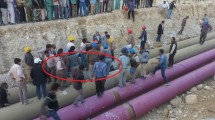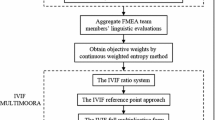Abstract
Failure modes and effects analysis (FMEA) is a commonly used method in risk evaluation. In this paper, a novel FMEA model based on neutrosophic analytic hierarchy process (NAHP) is proposed to overcome shortcomings of the risk prioritization of classical FMEA. Neutrosophic sets approach real-world decision-making problems from a three-aspect structure (i.e., truthiness, indeterminacy and falsity). Therefore, initially, AHP is merged with neutrosophic sets to assign importance weights to risk parameters in FMEA. The encountered failure modes are then prioritized with respect to the previously weighted risk parameters. Each element in AHP comparison matrices is considered as triangular neutrosophic numbers, and score functions are used to transform NAHP elements to deterministic values. The flexibility of determining the weight to each parameter of FMEA (severity, occurrence and detection) and evaluation of each failure mode against these parameters are more well-suited to the real decision-making condition. Finally, a case study in the textile industry is provided to show the applicability of the novel model. Sensitivity and comparative analysis are also performed to validate the results.









Similar content being viewed by others
References
Abdel-Basset M, Mohamed M (2019) A novel and powerful framework based on neutrosophic sets to aid patients with cancer. Future Gener Comput Syst
Abdel-Basset M, Mohamed M, Zhou Y, Hezam I (2017) Multi-criteria group decision making based on neutrosophic analytic hierarchy process. J Intell Fuzzy Syst 33(6):4055–4066
Abdel-Basset M, Mohamed M, Sangaiah AK (2018a) Neutrosophic AHP-Delphi Group decision making model based on trapezoidal neutrosophic numbers. J Ambient Intell Humaniz Comput 9(5):1427–1443
Abdel-Basset M, Manogaran G, Gamal A, Smarandache F (2018b) A hybrid approach of neutrosophic sets and DEMATEL method for developing supplier selection criteria. Des Autom Embed Syst 22:257–278
Abdel-Basset M, Manogaran G, Mohamed M, Chilamkurti N (2018c) Three-way decisions based on neutrosophic sets and AHP-QFD framework for supplier selection problem. Futur Gener Comput Syst 89:19–30
Abdel-Basset M, Mohamed M, Smarandache F (2018d) An extension of neutrosophic AHP–SWOT analysis for strategic planning and decision-making. Symmetry 10(4):116
Akyuz E, Celik E (2018) A quantitative risk analysis by using interval type-2 fuzzy FMEA approach: the case of oil spill. Marit Policy Manag 45(8):979–994
Alonso JA, Lamata MT (2006) Consistency in the analytic hierarchy process: a new approach. Int J Uncertain Fuzziness Knowl Syst 14(04):445–459
Bakır M, Atalık Ö (2021) Application of fuzzy AHP and fuzzy MARCOS approach for the evaluation of e-service quality in the airline industry. Decis Mak Appl Manag Eng 4(1):127–152
Başhan V, Demirel H, Gul M (2020) An FMEA-based TOPSIS approach under single valued neutrosophic sets for maritime risk evaluation: the case of ship navigation safety. Soft Comput 24(24):18749–18764
Bian T, Zheng H, Yin L, Deng Y (2018) Failure mode and effects analysis based on D numbers and TOPSIS. Qual Reliab Eng Int 34(4):501–515
Bozdag E, Asan U, Soyer A, Serdarasan S (2015) Risk prioritization in failure mode and effects analysis using interval type-2 fuzzy sets. Expert Syst Appl 42(8):4000–4015
Catelani M, Ciani L, Venzi M (2018) Failure modes, mechanisms and effect analysis on temperature redundant sensor stage. Reliab Eng Syst Saf 180:425–433
Chang DY (1996) Applications of the extent analysis method on fuzzy AHP. Eur J Oper Res 95(3):649–655
Du Y, Lu X, Su X, Hu Y, Deng Y (2016) New failure mode and effects analysis: an evidential downscaling method. Qual Reliab Eng Int 32(2):737–746
Fattahi R, Khalilzadeh M (2018) Risk evaluation using a novel hybrid method based on FMEA, extended MULTIMOORA, and AHP methods under fuzzy environment. Saf Sci 102:290–300
Fattahi R, Tavakkoli-Moghaddam R, Khalilzadeh M, Shahsavari-Pour N, Soltani R (2020) A novel FMEA model based on fuzzy multiple-criteria decision-making methods for risk assessment. J Enterp Inf Manag
Ghoushchi SJ, Yousefi S, Khazaeili M (2019) An extended FMEA approach based on the Z-MOORA and fuzzy BWM for prioritization of failures. Appl Soft Comput 81:105505
Gul M (2018) A review of occupational health and safety risk assessment approaches based on multi-criteria decision-making methods and their fuzzy versions. Hum Ecol Risk Assess Int J 24(7):1723–1760
Gul M, Ak MF (2018) A comparative outline for quantifying risk ratings in occupational health and safety risk assessment. J Clean Prod 196:653–664
Gul M, Ak MF (2021) A modified failure modes and effects analysis using interval-valued spherical fuzzy extension of TOPSIS method: case study in a marble manufacturing facility. Soft Comput 1–22
Gul M, Guneri AF, Nasirli SM (2018) A fuzzy-based model for risk assessment of routes in oil transportation. Int J Environ Sci Technol 1–16
Guneri AF, Gul M, Ozgurler S (2015) A fuzzy AHP methodology for selection of risk assessment methods in occupational safety. Int J Risk Assess Manag 18(3–4):319–335
Guo J, Lin Z, Zu L, Chen J (2018) Failure modes and effects analysis for CO 2 transmission pipelines using a hesitant fuzzy VIKOR method. Soft Comput 1–18
Hu YP, You XY, Wang L, Liu HC (2018) An integrated approach for failure mode and effect analysis based on uncertain linguistic GRA–TOPSIS method. Soft Comput 1–14
Huang J, Li ZS, Liu HC (2017) New approach for failure mode and effect analysis using linguistic distribution assessments and TODIM method. Reliab Eng Syst Saf 167:302–309
Huang Z, Jiang W, Tang Y (2018) A new method to evaluate risk in failure mode and effects analysis under fuzzy information. Soft Comput 22(14):4779–4787
Ilbahar E, Karaşan A, Cebi S, Kahraman C (2018) A novel approach to risk assessment for occupational health and safety using Pythagorean fuzzy AHP & fuzzy inference system. Saf Sci 103:124–136
Kahraman C, Öztayşi B, Sarı İU, Turanoğlu E (2014) Fuzzy analytic hierarchy process with interval type-2 fuzzy sets. Knowl Syst 59:48–57
Karasan A, Erdogan M (2021) Creating proactive behavior for the risk assessment by considering expert evaluation: a case of textile manufacturing plant. Complex Intell Syst. https://doi.org/10.1007/s40747-020-00246-0
Karasan A, Ilbahar E, Cebi S, Kahraman C (2018) A new risk assessment approach: safety and critical effect analysis (SCEA) and its extension with Pythagorean fuzzy sets. Saf Sci 108:173–187
Khalilzadeh M, Ghasemi P, Afrasiabi A, Shakeri H (2021) Hybrid fuzzy MCDM and FMEA integrating with linear programming approach for the health and safety executive risks: a case study. J Model Manag
Kim KO, Zuo MJ (2018) General model for the risk priority number in failure mode and effects analysis. Reliab Eng Syst Saf 169:321–329
Kutlu AC, Ekmekçioğlu M (2012) Fuzzy failure modes and effects analysis by using fuzzy TOPSIS-based fuzzy AHP. Expert Syst Appl 39(1):61–67
Liu HC (2016) FMEA using uncertainty theories and MCDM methods. In: FMEA using uncertainty theories and MCDM methods. Springer, Singapore, pp 13–27
Liu HC, Chen YZ, You JX, Li H (2016) Risk evaluation in failure mode and effects analysis using fuzzy digraph and matrix approach. J Intell Manuf 27(4):805–816
Liu HC, Liu L, Liu N (2013) Risk evaluation approaches in failure mode and effects analysis: a literature review. Expert Syst Appl 40(2):828–838
Lo HW, Liou JJ, Huang CN, Chuang YC (2019) A novel failure mode and effect analysis model for machine tool risk analysis. Reliab Eng Syst Saf 183:173–183
Lo HW, Shiue W, Liou JJ, Tzeng GH (2020) A hybrid MCDM-based FMEA model for identification of critical failure modes in manufacturing. Soft Comput 24(20):15733–15745
Mete S (2018) Assessing occupational risks in pipeline construction using FMEA based AHP-MOORA integrated approach under Pythagorean fuzzy environment. Hum Ecol Risk Assess Int J. https://doi.org/10.1080/10807039.2018.1546115
Mutlu NG, Altuntas S (2019a) Risk analysis for occupational safety and health in the textile industry: Integration of FMEA, FTA, and BIFPET methods. Int J Ind Ergon 72:222–240
Mutlu NG, Altuntas S (2019b) Hazard and risk analysis for ring spinning yarn production process by integrated FTA-FMEA approach. Tekstil ve Konfeksiyon 29(3):208–218
Ortega RG, Vázquez ML, Figueiredo JAS, Guijarro-Rodriguez A (2018) Sinos river basin social-environmental prospective assessment of water quality management using fuzzy cognitive maps and neutrosophic AHP-TOPSIS. Neutrosophic Sets Syst 23:160–171
Oz NE, Mete S, Serin F, Gul M (2018) Risk assessment for clearing & grading process of a natural gas pipeline project: an extended TOPSIS model with Pythagorean fuzzy sets for prioritizing hazards. Hum Ecol Risk Assess Int J. https://doi.org/10.1080/10807039.2018.1495057
Ozdemir Y, Gul M, Celik E (2017) Assessment of occupational hazards and associated risks in fuzzy environment: a case study of a university chemical laboratory. Hum Ecol Risk Assess Int J 23(4):895–924
Öztaysi B, Onar SÇ, Boltürk E, Kahraman C (2015) Hesitant fuzzy analytic hierarchy process. In: 2015 IEEE international conference on fuzzy systems (FUZZ-IEEE). IEEE, pp 1–7
Özyazgan V (2014) Dokuma kumaş üretimi yapan bir tekstil fabrikasında HTEA analizi ve uygulaması. Tekstil ve Konfeksiyon 24(3):303–308
Özyazgan V, Engin FZ (2013) FMEA analysis and applications in knitting industry. J Text Appar/Tekstil ve Konfeksiyon 23(3):228–232
Park J, Park C, Ahn S (2018) Assessment of structural risks using the fuzzy weighted Euclidean FMEA and block diagram analysis. Int J Adv Manuf Technol 1–10
Saaty TL (1977) A scaling method for priorities in hierarchical structures. J Math Psychol 15(3):234–281
Saaty TL (1980) The analytic hierarchy process: planning, priority setting, resource allocation. McGraw Hill, New York
Saaty TL (1990) How to make a decision: the analytic hierarchy process. Eur J Oper Res 48(1):9–26
Saaty TL (1996) The analytic network process: decision making with dependence and feedback. RWS Publications, Pittsburgh
Safari H, Faraji Z, Majidian S (2016) Identifying and evaluating enterprise architecture risks using FMEA and fuzzy VIKOR. J Intell Manuf 27(2):475–486
Smarandache F (1998) Neutrosophy. Neutrosophic probability, set, and logic. ProQuest Information & Learning, Ann Arbor, p 105
Smarandache F (2002) Neutrosophy and neutrosophic logic. In: First international conference on neutrosophy, neutrosophic logic, set, probability, and Statistics University of New Mexico, Gallup, NM, vol 87301, pp 338–353
Smarandache F (2005) Neutrosophic set-a generalization of the intuitionistic fuzzy set. Int J Pure Appl Math 24(3):287
Smarandache F (ed) (2003) A unifying field in logics: Neutrosophic logic. neutrosophy, neutrosophic set, neutrosophic probability: Neutrosophic logic: neutrosophy, neutrosophic set, neutrosophic probability. Infinite Study
Tzeng GH, Huang JJ (2011) Multiple attribute decision making: methods and applications. CRC Press
Wang H, Smarandache F, Zhang Y, Sunderraman R (2010) Single valued neutrosophic sets. Infinite study
Wang W, Liu X, Qin Y (2018) A fuzzy Fine-Kinney-based risk evaluation approach with extended MULTIMOORA method based on Choquet integral. Comput Ind Eng 125:111–123
Xu Z, Liao H (2014) Intuitionistic fuzzy analytic hierarchy process. IEEE Trans Fuzzy Syst 22(4):749–761
Yazdi M, Nedjati A, Zarei E, Abbassi R (2020) A reliable risk analysis approach using an extension of best-worst method based on democratic-autocratic decision-making style. J Clean Prod 256:120418
Yucesan M, Gul M (2019) Failure prioritization and control using the neutrosophic best and worst method. Granul Comput 1–15
Yucesan M, Kahraman G (2019) Risk evaluation and prevention in hydropower plant operations: a model based on Pythagorean fuzzy AHP. Energy Policy 126:343–351
Yucesan M, Gul M, Celik E (2021) A holistic FMEA approach by fuzzy-based Bayesian network and best–worst method. Complex Intell Syst 1–18
Yücel Ö (2007) Konfeksiyon üretiminde hata türü ve etkileri analizi. Tekstil ve Konfeksiyon 17(2):126–131
Zhao H, You JX, Liu HC (2017) Failure mode and effect analysis using MULTIMOORA method with continuous weighted entropy under interval-valued intuitionistic fuzzy environment. Soft Comput 21(18):5355–5367
Author information
Authors and Affiliations
Corresponding author
Ethics declarations
Conflict of interest
All authors declare that they have no conflict of interest.
Ethical approval
This article does not contain any studies with animals performed by any of the authors.
Additional information
Publisher’s Note
Springer Nature remains neutral with regard to jurisdictional claims in published maps and institutional affiliations.
Rights and permissions
About this article
Cite this article
Yucesan, M., Gul, M. Failure modes and effects analysis based on neutrosophic analytic hierarchy process: method and application. Soft Comput 25, 11035–11052 (2021). https://doi.org/10.1007/s00500-021-05840-z
Accepted:
Published:
Issue Date:
DOI: https://doi.org/10.1007/s00500-021-05840-z




